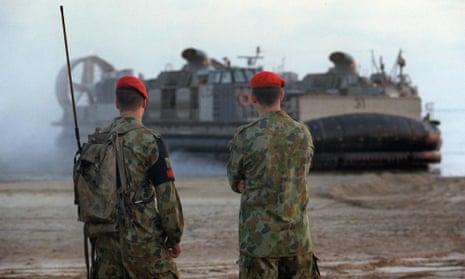News this week of the startling growth of Chinese construction on contested reefs in the South China Sea has caused mass hysteria in the world’s media. As the idea that the US is “losing Asia”, while China constructs a new “great wall of sand”, begins to take hold, and American commanders begin requesting Australian participation in “hunter-killer” patrols in the region, the Australian public would do well to look into our own backyard for the origins of the escalating regional military buildup.
Later this month, as the monsoon subsides and soft mud becomes solid ground, the permanent rotation of US marines through Darwin will enter its next iteration. Another 1,150 marines will arrive in the Top End, bringing with them a plethora of vehicles, weapons and ammunition.
The Australian defence minister will laud it as a boost to the local economy, the American commander will make a statement about the benefits of training with Australian troops, and the nation will continue in lockstep with the American strategy to contain a rising China through a regional military buildup without a skerrick of earnest public discussion.
While the Australian media may wax lyrical about the threat posed to regional stability by Chinese construction in the South China Sea, they have been conspicuously quiet on the military buildup in the Northern Territory. If an honest appraisal of the broader geopolitical significance of the marine deployment is what you’re after, you will have much better luck finding it between the pages of a Chinese newspaper than in one of our own broadsheets. In Chinese media, details of the rotation, along with the similarly underreported plans to use the Australian Cocos Islands as a base for American drones, are represented as what they in fact are: clear evidence that Australia is siding with the US in a program of strategic containment of China.
The deployment is also better contextualised in the Chinese press. Chinese commentators, including some of their top military officials, discuss Australia’s long history of strategic dependence on foreign (Anglo-Saxon) powers, and challenge Australians to stop simply paying lip service to the idea of being a committed member of the Asian community while acting as an uncritical proxy of the US.
It is unsurprising that Australians are only vaguely aware that the first ever permanent peacetime deployment of foreign troops in the nation’s history is now occurring. The yarns spun by our politicians portray the deployment, which will swell to at least 2,500 marines over the next few years, as doing all things for all people. To our wary southeast Asian neighbours, the rotation is presented as a humanitarian aid and disaster relief operation, ready to spring into action at the first whiff of a meteorological event. Nationally, it is downplayed as a mere “troop rotation” and “interoperability” exercise, an end in itself with no greater military implication. Locally, an upsurge in jobs servicing the American troops is promised, as too is an influx of foreign currency to be spent on entertainment, infrastructure and tourism.
Despite the Australian government’s diversions, the rotation has much broader significance; it is a key node in America’s much vaunted “pivot to Asia”, a once-in-a-generation strategic shift through which the US seeks to maintain its regional military dominance in the face of a rising China.
“Marine Rotational Force – Darwin” (MRF-D) is one of four American marine air ground task forces (MAGTFs) in the Asia-Pacific region, along with those in Guam, Hawaii and Okinawa, the sum of which make up a central strategic pillar of the pivot. According to the US Marine Corp each MAGTF is “designed to thoroughly exploit the combat power inherent in air and ground assets by closely integrating them into a single force”. They have rapid deployment capabilities and are best used to swiftly seize objectives through which further, more substantial, military assets can surge through.
While the anxiety over a rising China may be new, Australia’s fear of its Asian neighbours and consequent desire for patronage from a foreign power are as old as the nation itself. In 1977 the eminent Australian international relations theorist Hedley Bull summarised Australia’s core anxiety as that of a tiny population commanding a continent the size of Europe, rich in food, energy, and raw materials, and with a gross national product that easily surpasses that of its far more populous south-east Asian neighbours, a situation which it believed must surely be brought to an end at some point by an envious Asian “other”.
It is this defining and unchanging fact of Australian foreign policy, and the long history of strategic dependence, that creates a false dichotomy in the minds of Australian policymakers. They see a choice between either total support for the US in its quest to maintain a position of regional primacy, or abandonment of the alliance to passively await regional domination by China. A middle position, in which Australia continues to support the US playing a positive role in the region, while conducting a truly independent foreign policy that aims to dampen regional military tension and promote unbiased multilateral dispute resolution, is unthinkable.
Recent news of Chinese military construction in the South China Sea is troubling, but in the context of the unprecedented American regional military expansion that has been occurring for years it is unsurprising. If the Australian government desires to dampen regional tensions, and seek a path different from unquestioning support for the US in a zero-sum confrontation with China, an honest dialogue on how our foreign policy supports the national interest must be undertaken. While the nature and purpose of the Darwin marine rotation remains obscured, the prospects for this are bleak.
